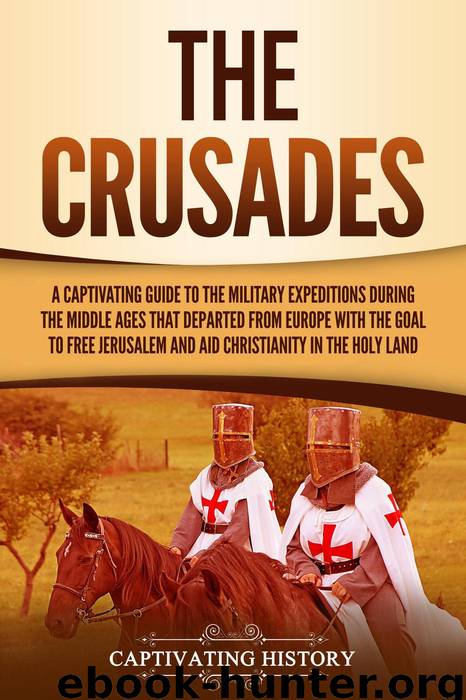The Crusades: A Captivating Guide to the Military Expeditions During the Middle Ages That Departed from Europe with the Goal to Free Jerusalem and Aid Christianity in the Holy Land by Captivating History

Author:Captivating History
Language: eng
Format: epub
Publisher: Captivating History
Published: 2019-09-07T16:00:00+00:00
Chapter 6 – The Fourth Crusade (1202–1204) – The Latin Empire of Constantinople and the Children’s Crusade
The failure of the Third Crusade to restore Jerusalem, the holiest of all Christian places on earth, to Christian control irked European ecclesiastics. First among them was Pope Innocent III, who had been elected to the highest church office in January 1198. He viewed Saladin’s capture of Jerusalem in 1187 as a result of the moral degeneration of Christian princes. Because they were wanting in moral authority, Innocent III considered secular authorities unqualified to make appointments to ecclesiastical offices and entirely unjustified in meddling in Church affairs. Partly to emphasize his authority, Innocent III published a papal bull, Post Miserabile, in which he called for a new Crusade shortly after his election. He began by stating that the Muslims believed that they had “weakened and shattered the spears of the French” and that they had “crushed the efforts of the English.” According to the pope, the Muslims were basking in their defeat of the Christians, saying that their victory was made possible because the Crusaders “prefer to fight each other in turn than to experience once more our might and power.” The pope called for ecclesiastics to call for a renewal of the Crusading spirit, for Christians to renew their religious enthusiasm and pay attention “to how our enemies persecute us.” Among the most successful in carrying the pope’s message to the people was Fulk of Neuilly, a French cleric who persuaded Count Theobald III, Count of Champagne, to take the cross. Theobald was chosen as the first leader of the new Crusade, but he died in 1201. He was replaced as the primary leader of the Crusade by Italian Boniface I, Marquess of Montferrat, whose father had been on the Second Crusade and whose brothers were William “Longsword,” Count of Jaffa and Ascalon (also known as Ashkelon), and King Conrad of Jerusalem. Boniface, according to his friend and court poet, Raimbaut de Vaqueiras, had already engaged in knightly activities that merited the honor of being told about in lyrical ballads. He had rescued an heiress, Jaopina of Ventimiglia, whose uncle imprisoned her in an attempt to steal her inheritance. He also rode to the rescue of Saldina de Mar, the daughter of a Genoese merchant who had been abducted by Boniface’s brother-in-law. Boniface kindly restored her to the arms of her lover. Clearly, Boniface of Montferrat had the qualities necessary for leading a Crusade.
When he called for the launch of the Fourth Crusade, Innocent received significant support in France. He funded the campaign by first levying a tax on the clergy, who were to render up one-fortieth of their income, and then cajoling the English monarch, King John, and King Philip II of France to pledge a similar amount of their income to the cause. King John also decided that this tax would be collected throughout his kingdom. This commitment was to have important repercussions on the extent of his power as king.
The
Download
This site does not store any files on its server. We only index and link to content provided by other sites. Please contact the content providers to delete copyright contents if any and email us, we'll remove relevant links or contents immediately.
| Africa | Americas |
| Arctic & Antarctica | Asia |
| Australia & Oceania | Europe |
| Middle East | Russia |
| United States | World |
| Ancient Civilizations | Military |
| Historical Study & Educational Resources |
Room 212 by Kate Stewart(4130)
The Crown by Robert Lacey(4123)
Endurance: Shackleton's Incredible Voyage by Alfred Lansing(3864)
The Iron Duke by The Iron Duke(3661)
The Rape of Nanking by Iris Chang(3539)
Killing England by Bill O'Reilly(3471)
Joan of Arc by Mary Gordon(3279)
Say Nothing by Patrick Radden Keefe(3083)
I'll Give You the Sun by Jandy Nelson(2853)
Shadow of Night by Deborah Harkness(2755)
Hitler's Monsters by Eric Kurlander(2744)
Margaret Thatcher: The Autobiography by Thatcher Margaret(2694)
Mary, Queen of Scots, and the Murder of Lord Darnley by Alison Weir(2685)
Darkest Hour by Anthony McCarten(2658)
Blood and Sand by Alex Von Tunzelmann(2618)
Red Famine: Stalin's War on Ukraine by Anne Applebaum(2476)
Eleanor & Park by Rainbow Rowell(2406)
The One Memory of Flora Banks by Emily Barr(2360)
Book of Life by Deborah Harkness(2291)
